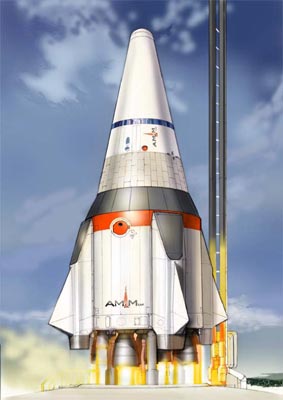|
|
 (illustration credit: Doug Birkholz) |
Review: The Rocket Company
by Jeff Foust
Monday, February 23, 2004
The Rocket Company
By Patrick J. G. Stiennon & David M. Hoerr
Unpublished, serialized at HobbySpace.com
Future historians will no doubt consider the latter half of the 1990s to be one of the more interesting periods in the history of space development, not for what happened but for what was expected to happen. During this time several companies made serious efforts to develop reusable launch vehicles (RLVs) that would serve what was forecast to be a burgeoning market for communications satellites—and in the process not so subtly tweak NASA. Of course, it didn’t turn out that way: the market for such satellites collapsed in the wake of the financial failures of Iridium and related companies, taking with it many of the companies that planned to build RLVs before they could build anything more than models and low-level flight demonstrators.
The collapse of the RLV industry before any of the companies could fly RLVs left unanswered a key question: was it, in fact, possible to commercially develop an RLV? There have been any number of critics skeptical of proposed RLV designs, particularly single stage to orbit (SSTO) concepts. Given the many problems NASA has had with RLV projects (an effort that the agency is now largely abandoning to focus on the new space exploration initiative), it’s easy to question whether private interests, often strapped for capital, could do any better. A fiction book currently in progress, The Rocket Company, poses a fascinating what-if question: what if a company, possessing sufficient financial support, actually tried to develop an RLV?
The Rocket Company is set in the very near future, after the initial rise and fall of RLV ventures. A group of private investors, led by software magnate John Forsyth, pooled their resources to the tune of $1 billion to fund a new company, AM&M, to build a two stage to orbit (TSTO) RLV. The book, the first 18 chapters of which have been published at HobbySpace.com, covers in great detail much of the technical development of such a vehicle, along with financial, regulatory, and marketing issues, told from the point of view of a journalist invited into the project to chronicle its development.
| The book lies somewhere in a no man’s land between a novel and an engineering text. |
The book, as it currently stands, is a mixed bag. As a work of fiction it is a disappointment. While the development of an RLV will certainly be of interest, the plot lacks a clear antagonist and source of conflict crucial to any successful novel. Most of the characters introduced in the book to date are less one-dimensional than zero-dimensional: they exist solely to lecture the narrator on the finer points of metallurgy, propellants, and spacesuit design, and then disappear, their function in the book apparently fulfilled.
It’s those lectures, though, that represent the heart of this book. Nearly every chapter contains a wealth of information about various aspects of RLV design and development, as well as economic and regulatory concerns. The authors know the material well: both worked on a number of launch vehicle projects for companies as varied as Lockheed and Pacific American Launch Systems. They’re not afraid to delve deep into technical details and minutiae to explain why a particular design approach has been chosen.
Therein lies the quandary of The Rocket Company. The book lies somewhere in a no man’s land between a novel and an engineering text. Judged solely on its merits as a novel the book would be considered very poor, but in reality the story serves as a vessel to communicate the merits of a particular TSTO RLV design. One could strip out the fictional elements and instead have a straightforward engineering treatise about RLVs, but that arguably would be less entertaining to read. An alternative would be to build up, rather than strip out, the literary elements of the book: make the characters more multidimensional and add some conflict to the plot. This would increase the potential audience of the book to some degree, although there will still be limits: not everyone is interested in a novel that includes AIAA paper references! Regardless, The Rocket Company still holds promise as a means of describing how one could build an RLV.
Jeff Foust (jeff@thespacereview.com) is the editor and publisher of The Space Review. He also operates the Spacetoday.net web site. He has also recently started a weblog titled Space Politics to track space policy issues.
|
|
